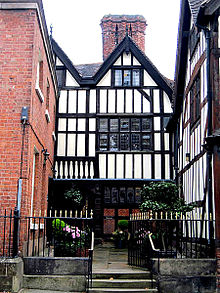Drapers Company of Shrewsbury

Drapers Hall, Shrewsbury, now a boutique hotel
|
|
| Formation | 1462 |
|---|---|
| Founded at | Shrewsbury, Shropshire, England |
| Type | Charity |
| Registration no. | Charity No: 1132671 |
| Legal status | Active |
| Purpose | Operation of almshouses |
| Headquarters | 1 Frankwell, Shrewsbury, SY3 8LG |
| Coordinates | 52°42′39″N 2°45′34″W / 52.710946°N 2.759567°WCoordinates: 52°42′39″N 2°45′34″W / 52.710946°N 2.759567°W |
|
Region
|
Shrewsbury |
| Services | Low-income housing |
| Website | shrewsburydrapers |
The Shrewsbury Drapers Company was a trade organisation founded in 1462 in the town of Shrewsbury, Shropshire, England. The members were wholesale dealers in wool or woollen cloth. The Company dominated the trade in Welsh cloth for many years, holding a virtual monopoly from the 16th century to the late 18th century. It lost its position when the roads were improved, making it practical for factors from Liverpool and elsewhere to travel into Wales and purchase cloth directly from the makers, and became irrelevant when the Industrial Revolution made trade guilds obsolete. Today it survives as a charity that runs almshouses in Shrewsbury.
Shrewsbury in 1334 was the 7th wealthiest town in England outside of London, and was well situated to handle trade from north and central Wales in time of peace. The drapers took the role of middlemen when the trade in raw wool was replaced by trade in woollen cloth. In the late 12th and 13th centuries all trade in Shrewsbury was controlled by the Guild Merchants. By the late 14th century the drapers had become an independent guild with commercial, religious and political functions. In 1444 the drapers guild founded almshouses beside St Mary's Church that housed 13 residents. The Mercers' Company remained the richest and strongest trade organisation in Shrewsbury in the 15th century.
The Shrewsbury Drapers Company was incorporated by Edward IV in 1462 by a royal charter that called the Company "A Fraternity or Gild of the Holy Trinity of the Men of the Mystery of Drapers in the town of Salop". In 1470 the weavers of Shrewsbury obtained an order by the town authorities that banned the drapers from bringing in Welsh cloth. The prohibition proved unsustainable. As part of the religious charter a chantry priest was appointed by the guild to say Mass for the guild in the chapel of St Mary's Church. The Company erected an altar in the chantry chapel of St Mary's in 1501, part of which still exists.
In the early 16th century Welsh cloth for export was mainly produced in south Wales and shipped from the local ports. During that century there was a shift in production to mid-Wales and north Wales. After the Act of Union in 1536 the Shrewsbury Drapers provided an increasingly important export market for Welsh light coarse cloths, known as cottons, friezes and flannel. The Mercers, who retailed cloth, had formerly claimed a share of the Welsh trade, as had the Shearmen, who finished the cloth. In the early 16th century the Drapers shut the Mercers out of the trade and make the Shearmen purely subcontractors, creating an effective monopoly.
...
Wikipedia
